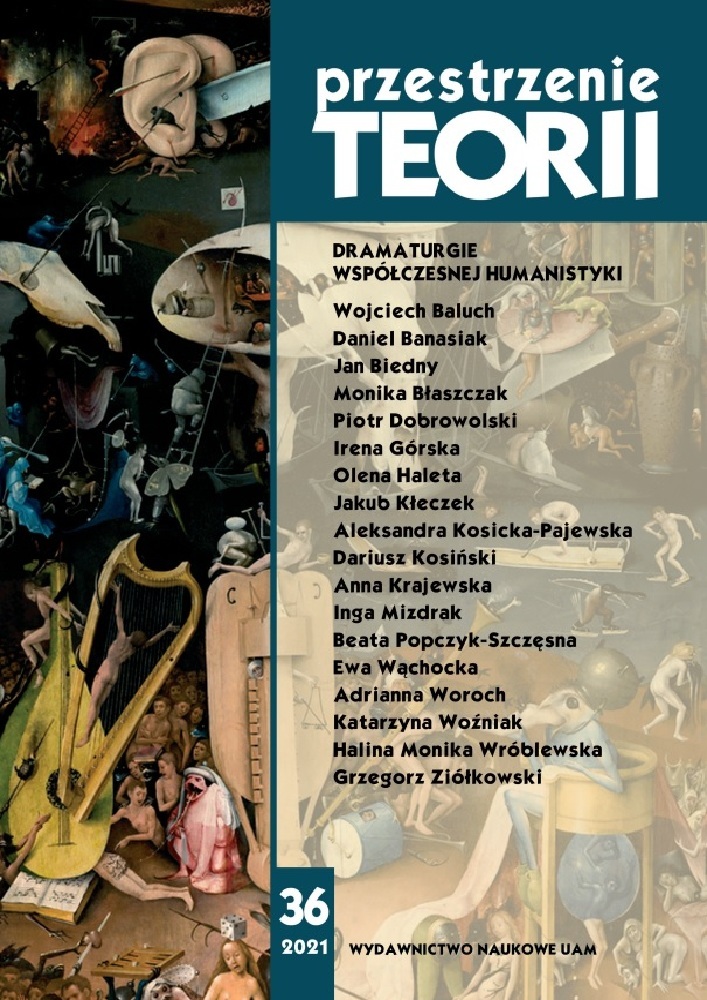Abstrakt
The article is an attempt to answer the question of how contemporary performative acting enters into artistically and cognitively significant interactions with the new Polish dramaturgy. The relationship between the two forms of art is discussed in relation to two types of acting: task-oriented and performative. The concept of both types of acting is derived from the analysis of selected contemporary theater and television productions of dramas and scenarios arising from the achievements of the latest Polish dramaturgy. The examples that are analyzed reveal various aspects and types of the actors’ performative game, which include the issues of the actor’s subjectivity, their presence on stage and the materiality of the body. Unlike many of today’s discussions, the interpretations and comments on selected scenes and fragments of a performance do not focus on the subversive dimension of the above-mentioned aspects of acting, but look for new perspectives of reception and, at the same time, broaden the areas of theatrical experience. These new perspectives and areas are triggered by references to the affective and mental processes of reception, which allow perceptions to exclude, at least partially, the tendency to automatically interpret everything that surrounds them. The analyses featured in the article therefore aim to describe those aspects of performative acting that enable the viewer to derive benefit from what the new Polish dramaturgy offers.
Bibliografia
Katafiasz O., Pułapka nadmiaru, teatralny.pl, https://teatralny.pl/recenzje/pulapka-nadmiaru,1141.html (dostęp: 20.07.2021).
Kościelniak M., Spektakl terrorystyczny, e-teatr, https://e-teatr.pl/spektakl-terrorystyczny-a196414 (dostęp: 20.07.2021).
Kyzioł A., Hamlet roz(s)trojony, „Polityka” 23 czerwca 2015.
Mrozek W., Świetny spektakl „Wszystko o mojej matce”. Co łączy Borczucha z Almodóvarem?, wyborcza.pl, https://wyborcza.pl/7,75410,19982317,swietny-spektakl-wszystko-o-mojej-matce-co-laczy-borczucha.html (dostęp: 20.07.2021).
Soszyński P., Język rozkłada każde ciało, https://e-teatr.pl/jezyk-rozklada-kazde-cialo-a197199 (dostęp: 20.07.2021).
Targoń J., Hamlet przekręcony, gazeta.pl, https://krakow.wyborcza.pl/krakow/7,35796,18129193,stary-teatr-hamlet-przekrecony-recenzja.html (dostęp: 20.07.2021).
Licencja
Autorzy
Autorzy tekstów przyjętych do publikacji w czasopiśmie „Przestrzeniach Teorii” są zobowiązani do wypełnienia, podpisania i odesłania na adres redakcji umowy o udzielenie nieodpłatnej licencji do utworów, z zobowiązaniem do udzielania sublicencji CC.
Zgodnie z umową, autorzy tekstów opublikowanych w czasopiśmie „Przestrzeniach Teorii” udzielają Uniwersytetowi im. Adama Mickiewicza w Poznaniu niewyłącznej i nieodpłatnej licencji oraz zezwalą na użycie sublicencji Creative Commons Attribution-NonCommercial-NoDerivatives 4.0 International (CC BY-NC-ND 4.0).
Autorzy zachowują prawa do dalszego, swobodnego rozporządzania utworem.
Autorzy, którzy wykorzystują w swoim tekście cudze utwory (np. ilustracje, fotografie) proszeni są o dostarczenie do redakcji czasopisma zgodę na publikację od uprawnionych podmiotów.
Użytkownicy
Zainteresowani użytkownicy internetu uprawnieni są do korzystania z utworów opublikowanych po 2015 roku „Przestrzeniach Teorii” tylko w calach niekomercyjnych, pod następującymi warunkami:
- uznanie autorstwa - obowiązek podania wraz z rozpowszechnionym utworem, informacji, o autorstwie, tytule, źródle (odnośniki do oryginalnego utworu, DOI) oraz samej licencji;
- bez tworzenia utworów zależnych - utwór musi być zachowany w oryginalnej postaci, nie można bez zgody twórcy rozpowszechniać np. tłumaczeń, opracowań.
Do wszystkich tekstów opublikowanych przed 2015 r. prawa autorskie są zastrzeżone.
Inne
Uniwersytet im. Adama Mickiewicza w Poznaniu zachowuje prawo do czasopisma jako całości (układ, forma graficzna, tytuł, projekt okładki, logo itp.).

